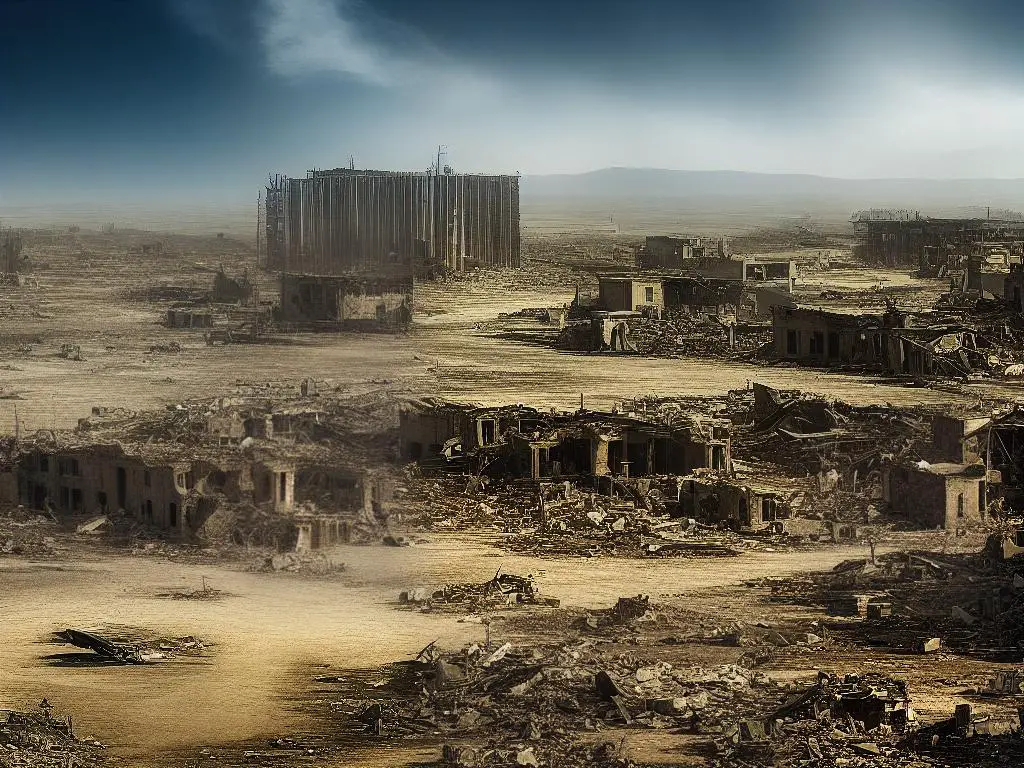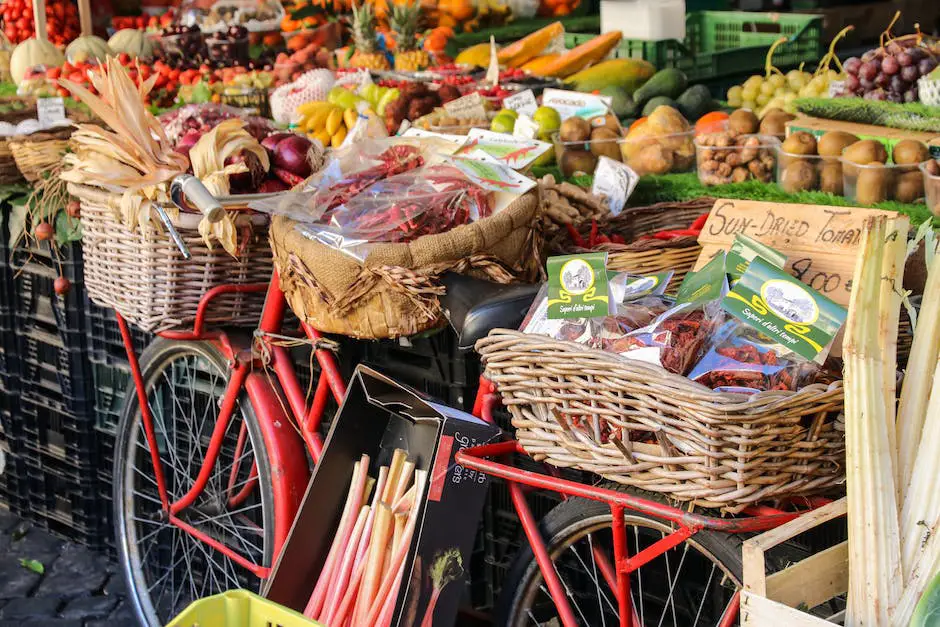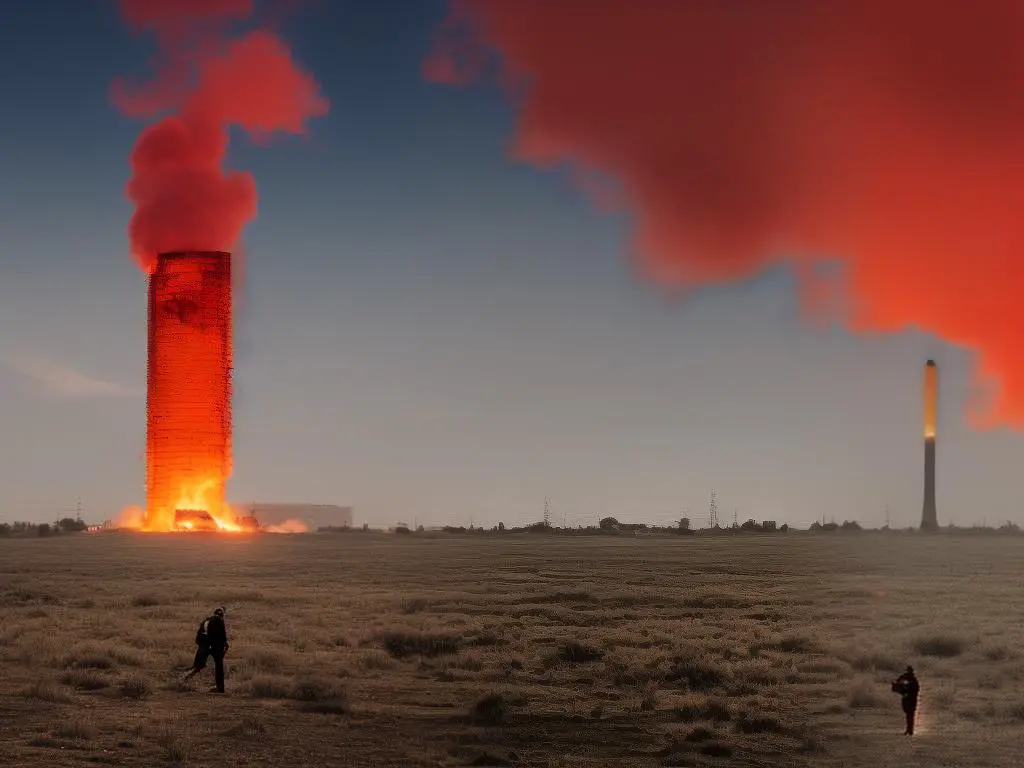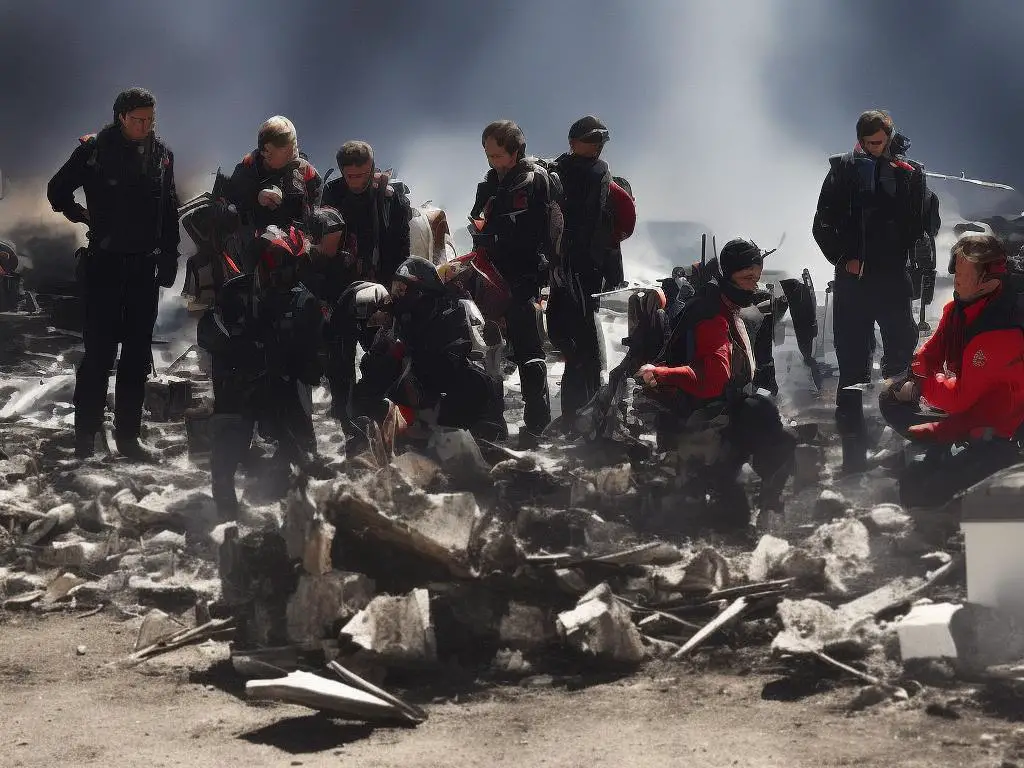Imagine a world torn apart by disasters, where familiar landscapes have been replaced with desolation, and the remnants of humanity must forge new paths to survival. This vision, a post-apocalyptic world, has captured the imagination of countless minds and has seeped into various forms of media. Our collective fascination with such a devastating scenario might stem from the underlying awareness that our modern society is more fragile than we’d like to admit. However, by examining the potential causes of post-apocalyptic scenarios, survival strategies, and the rebuilding of society, we can learn invaluable lessons that could ultimately help us avoid – or better prepare for – such cataclysmic events.
Causes of Post-Apocalyptic Scenarios
Nuclear War: A Constant Threat
One potential cause of a post-apocalyptic world scenario is a full-scale nuclear war. With tens of thousands of nuclear weapons in existence, mostly stockpiled by the United States and Russia, the potential for human extinction due to such a conflict is significant. Apart from the immediate devastation caused by the detonation of these weapons, large-scale nuclear war could lead to a global environmental disaster, often known as nuclear winter. This would result in dust and other pollutants being injected into the atmosphere, which cools the Earth, reduces sunlight and disrupts global agricultural systems.
Despite the end of the Cold War and diplomatic efforts to reduce nuclear stockpiles, the chances of an accidental or intentional nuclear war remain significant. Tensions among nuclear-armed nations and the proliferation of weapon technology to unstable regions contribute to the risk. Humanity’s survival in a post-nuclear world would likely depend on communities that avoid direct targeting, are able to deal with radioactive fallout and can develop alternative food production methods to withstand reduced sunlight and harsh climate conditions.
Climate Change: A Slow and Unfolding Catastrophe
Another potential trigger for a post-apocalyptic world scenario is human-induced climate change. As emissions of greenhouse gases continue to increase, the consequences of climate change can become more drastic and increasingly irreversible. These impacts include rising sea levels, extreme weather events, devastating droughts, and mass displacement of human populations.
While governments and international organizations are working on efforts to reduce emissions and prepare for the impacts of climate change, progress has been slow, raising fears that a climate-related catastrophe could become more likely. Survival in such extreme conditions would be harsh, as resources become scarce, and territorial conflicts escalate. The adaptability and resilience of communities would play a crucial role in determining who survives.
Pandemics: Global Disease Outbreaks
The rise of global pandemics presents another possibility for a post-apocalyptic world. As demonstrated by recent events like the COVID-19 outbreak, infectious diseases can spread rapidly through interconnected global populations, causing widespread economic, social, and political disruptions. While the current pandemic exemplifies this, much more lethal diseases could emerge in the future.
The development of resistant microorganisms, combined with the widespread misuse of antibiotics, raises the risk of a “superbug” pandemic that could be far more lethal and difficult to treat. In a post-pandemic world, humanity’s survival would rely on our ability to develop effective treatments and vaccines quickly, along with implementing strict disease control measures to minimize further spread.
Asteroid Impact: A Sudden, Cataclysmic Event
Finally, an asteroid impact represents a sudden, cataclysmic trigger for a post-apocalyptic world. While the likelihood of a large asteroid impacting Earth is statistically low, the consequences would be globally catastrophic. Such an event could result in massive tsunamis, widespread fires, and a potential “nuclear winter” effect due to dust and debris launched into the atmosphere.
Current efforts are underway to identify and track potentially hazardous near-Earth objects (NEOs), but the resources dedicated to this task are limited. In the event of an asteroid impact, humanity’s survival would hinge on the ability to predict and, if possible, deflect the incoming object. Failing that, underground or underwater habitats, and space colonization efforts could potentially provide a refuge for a small portion of humanity.
Summary
In the face of various potential triggers that could lead to a post-apocalyptic world, humanity must be prepared to adapt to unique challenges and find innovative solutions for survival. Addressing the scale and nature of such events will necessitate continued investment in preventative measures and preparation for worst-case scenarios to avoid a catastrophic collapse of human civilization.

Surviving in a Post-Apocalyptic World
Food Production
Key to thriving in a post-apocalyptic world is securing a reliable food source, as relying on scavenging from supermarkets and abandoned farms is not sustainable long-term. This would mean learning to produce food, through growing crops and raising livestock. Ideal crops in these harsh environments would include hardy, easy-to-grow, and nutrient-dense options like potatoes, corn, beans, and tomatoes.
For livestock, smaller animals such as chickens, rabbits, and goats might be more manageable, providing valuable sources of meat, eggs, and milk. Additionally, sustainable methods of food production like aquaponics – raising fish and using their waste to fertilize crops – could prove invaluable in a post-apocalyptic society.
Water Purification
Clean, potable water is another necessity for survival. With the collapse of infrastructure, finding uncontaminated water sources can be a challenge. Rainwater collection systems, river or lake water, and even groundwater can be potentially contaminated by pollutants or disease-causing pathogens. Learning how to filter and purify water is essential for ensuring a safe supply for drinking, cooking, and cleaning purposes. Simple purification methods include boiling water, using iodine tablets or ultraviolet light, and creating DIY filters using sand, charcoal, and cloth.
Shelter Construction
Safe and secure shelter is a basic need for survival in a post-apocalyptic world. Whether you find yourself in an urban, suburban, or rural setting, knowing how to build or repair existing structures is invaluable. In an urban scenario, the focus may be on repairing damaged buildings, reinforcing weak structures, and clearing debris. In rural settings, the skills needed to build basic shelters, such as a lean-to or A-frame, will come in handy.
Understanding insulation and ventilation is crucial for keeping shelters warm in winter and cool in summer. Knowledge of simple construction techniques, such as using mud, clay, or sandbags, can provide valuable resources for creating stable and well-insulated walls. Carpentry and masonry skills are also essential for constructing more complex shelters and repairing existing structures.
Defense Tactics
A post-apocalyptic world can be dangerous, with the potential for human conflict over limited resources or encounters with dangerous wildlife. Knowing how to defend yourself, your shelter, and your resources is necessary to ensure your survival. Basic self-defense skills can be essential in the face of a human threat. Additionally, understanding how to create makeshift weapons or maintain firearms will be an invaluable skill.
Learning how to build simple traps can also serve as a means of defense against both human and animal threats. Knowledge of land navigation, camouflage, and stealth can help you avoid confrontations or gain a tactical advantage when necessary.
Introduction
As the world continues to face unprecedented challenges and uncertainties, preparing for potential disasters and the ability to survive in a post-apocalyptic world becomes increasingly important. Mastering essential skills such as producing food, purifying water, constructing shelter, and defending oneself drastically improves one’s chance of survival in a reality that has irreversibly changed.

Rebuilding Society and Governance
Government Types and Social Structures in a Post-Apocalyptic World
In the aftermath of a catastrophic event, various forms of government and social structures may emerge, as survivors forge new communities and adapt to new realities. These potential types include:
- Tribalism: Tight-knit tribes form when small groups of survivors band together, functioning as extended families with shared goals, resources, and decision-making processes. This type of social organization is typically highly localized and driven by personal relationships.
- Feudalism: When resources become scarce, powerful groups or individuals might institute a feudal system, providing protection and resources to less powerful individuals in exchange for fealty and labor. This structure can result in a highly stratified society with strict power hierarchies.
- Democracy: Some communities may attempt to replicate pre-apocalyptic democratic systems, where every individual has an equal say in governance and decision-making processes. Communities may choose a direct democracy, in which everyone votes on every issue, or a representative democracy, where elected leaders make decisions on behalf of the community.
- Theocracy: Religion and spirituality may become central organizing principles in a post-apocalyptic world, with societies implementing theocratic governments led by religious authorities who base laws and social norms on doctrines and holy texts.
- Autocracy: Single individuals might rise to power, establishing autocratic governments that rule with absolute authority and control over the entire society. This type of government can provide stability in a chaotic world but is often prone to corruption and abuses of power.
- Anarchy: Conversely, survivors may reject all forms of governance and social structure, choosing instead to operate as a loose, self-governing collective without any central authority. While this can promote high levels of individual freedom, it may also make it challenging to address larger-scale issues.
Organizing and Rebuilding Societies
In order to build stable, functioning societies in a post-apocalyptic world, several key factors must be considered:
- Resource Management: Communities must develop strategies for managing and distributing vital resources, including food, water, medical supplies, and energy sources. This might involve cultivating sustainable agriculture, redistributing existing resources, or trading with neighboring groups.
- Security and Defense: In a potentially hostile environment, societies need to be able to protect their members and territory from external threats. This may involve forming militia groups, constructing defensive infrastructure, and building alliances with neighboring communities.
- Education and Training: To ensure the continuation of skills and knowledge vital to community survival, educational systems need to be established. This could involve the creation of formal schools, informal apprenticeships, or community-based learning initiatives.
- Communication and Transportation: Establishing communication systems and transportation networks can help communities stay connected and foster cooperation across larger distances. This could involve repurposing pre-apocalyptic technologies, such as radio or vehicles, or developing new, locally-sourced solutions.
- Leadership Structures: To effectively govern and make decisions, societies need to develop clear leadership structures and decision-making processes. These structures might be based on pre-apocalyptic systems or adapted to fit the needs and values of the post-apocalyptic world.
- Cultural Preservation and Continuity: Rebuilding societies also involves preserving and promoting cultural heritage and traditions. This may involve maintaining religious practices, preserving works of art and literature, or fostering shared cultural practices like storytelling and music.
Introduction to the Post-Apocalyptic World Dream
Envisioning a post-apocalyptic world often brings to mind various possibilities of social structures and forms of government. From tribalism to democracy, communities must organize and prioritize factors such as resource management, security, and cultural preservation to create a functional and thriving society. As new challenges arise, it will be crucial for these emerging societies to remain adaptable and embrace cooperation and innovation to ensure long-term survival.

Psychological Effects of Post-Apocalyptic Life
Psychological Effects in a Post-Apocalyptic World
Moving forward, it’s vital to consider the aftermath of an apocalyptic event and how it extends far beyond mere physical survival. Among these challenges is the immense psychological toll such experiences have on the human psyche. Expanding on these ideas, this article delves into the psychological effects of post-apocalyptic life, the mental health challenges survivors face, and potential coping mechanisms to help individuals navigate and rebuild in the face of adversity.
Trauma in the Post-Apocalyptic World
Trauma is a prevalent aspect of post-apocalyptic life, with individuals experiencing both direct traumatic events (e.g., violence, destruction) and more insidious, chronic trauma stemming from their new environment. Such trauma can manifest through symptoms of post-traumatic stress disorder (PTSD), including flashbacks, nightmares, intense distress when confronted with reminders of the event, and emotional numbness. Additionally, survivors may develop anxiety disorders, depression, and substance use disorders as they struggle to cope with trauma’s effects.
Prolonged Stress and Its Effects
Beyond trauma from specific events, a post-apocalyptic world presents a constant state of stress for its inhabitants. Long-term stress has significant implications for an individual’s mental health, including the development of chronic anxiety, depression, and even physical health problems. As resources become scarce and individuals are forced to engage in high-stakes, life-or-death scenarios regularly, the psychological toll becomes all the more apparent.
Grieving Loss in a Post-Apocalyptic World
The loss of loved ones is an unfortunate reality in post-apocalyptic life. In the midst of constant danger and hardship, survivors must confront feelings of grief, guilt, and helplessness, alongside the responsibilities of day-to-day survival. This unique environment complicates the grieving process, often forcing individuals to suppress their emotions for the sake of self-preservation or group cohesion. Over time, this suppression can exacerbate mental health challenges and contribute to a sense of hopelessness and despair.
Coping Mechanisms and Resilience-Building Strategies
Despite the hardships faced in a post-apocalyptic world, human beings possess a remarkable capacity for resilience and adaptation. A variety of coping mechanisms and strategies can be employed to help individuals maintain their mental health in the face of adversity. These strategies include:
- Social Support: Maintaining connections with others can provide emotional support, reduce feelings of isolation, and promote a shared sense of purpose during difficult times.
- Self-Care: Engaging in self-care practices is crucial for preserving mental and physical well-being. This may include finding opportunities for relaxation, maintaining personal hygiene, and seeking medical care when necessary.
- Healthy Coping Strategies: Utilizing healthy coping strategies, such as mindfulness and meditation techniques, can help to mitigate stress and anxiety and promote a sense of calm amid chaos.
- Building a Sense of Purpose: Finding meaning and purpose in the face of adversity can provide a crucial source of motivation and hope. Individuals can seek out opportunities to contribute to their community, whether it be through rebuilding, mentoring others, or engaging in creative pursuits.
- Learning from Past Experiences: Acknowledging and learning from past trauma can promote resilience, as survivors integrate their experiences into their sense of self and find new ways to cope.
Conclusion
In a post-apocalyptic world, individuals face immense physical and psychological challenges. Survivors must navigate their way through desolation and hardship, making it crucial for them to prioritize mental health, resilience, and a sense of hope. Although the prospect of such a world is grim, understanding and addressing the psychological challenges it presents can support survivors as they seek to forge new paths in uncharted territory.

Ethics and Morality in Post-Apocalyptic Scenarios
The Complexity of Ethics and Morality
In a world where societal norms have crumbled, ethics and morality become exceptionally complex, often leaving survivors to wrestle with difficult questions and dilemmas. With the rules of civilization no longer applicable, individuals and groups must find their way through morally-challenging situations while attempting to secure resources, establish defenses, and create alliances. As they navigate these murky waters, survivors must confront questions about what it means to be human and the extent of their social and moral obligations in a seemingly irreparable world.
Resource Allocation
In a post-apocalyptic world, resources such as food, water, and shelter are scarce, and the need to allocate them among survivors creates numerous ethical challenges. At its core, this issue boils down to who should receive limited resources, and how these resources should be distributed. For example, should resources be given out on a first-come, first-serve basis, or should they be allocated according to perceived worth or need? This issue raises questions about fairness, the importance of individual versus the collective, and the value of human life.
In these situations, individuals may face decisions about whether to cooperate with others to share resources or to hoard resources for their own survival, potentially undercutting the chances of others. This dilemma highlights the tension between self-interest and the well-being of others, as well as the possible consequences of betraying trust and collaboration in the name of self-preservation.
Defense Strategies
Survivors in a post-apocalyptic world may also face ethical questions about what measures are justifiable to protect themselves, their families, and their communities from external threats. When confronted with danger, how should survivors respond? Is it morally acceptable to employ violence and other aggressive measures in self-defense, or should individuals strive for non-violent solutions and risk vulnerability?
Furthermore, there may be cases where violence or force is used pre-emptively to secure resources or territory, calling into question the morality of such actions. This issue highlights the conflict between protecting one’s own well-being and respecting the rights and dignity of others, as well as the possible implications of choosing violence over diplomacy and negotiation.
Forging Alliances
In the bleak world of a post-apocalyptic scenario, survivors often form groups or alliances for mutual aid and protection. However, deciding who to trust and ally with can be fraught with ethical dilemmas. When choosing potential partners, is it acceptable to prioritize those of similar backgrounds, values, or culture, potentially excluding others in need? Is it morally justifiable to deceive or manipulate others in pursuit of personal or group goals?
These dilemmas touch upon the notion of loyalty and the importance of trust in human relationships, as well as the potential consequences of forming alliances based on shared values and beliefs, which can lead to divisions, prejudice, and conflict.
The Potential for Compassion and Cooperation
While post-apocalyptic scenarios present numerous ethical challenges and moral dilemmas, they also offer opportunities for acts of kindness, compassion, and cooperation. In the face of extreme adversity, survivors may find that relying on shared humanity, empathy, and understanding is crucial to navigating a devastated world together. Examples of this might include sharing resources with strangers, offering shelter to those in need, or actively working to rebuild communities and connections.
In conclusion, the ethical and moral landscape of a post-apocalyptic world is fraught with difficult questions and choices. Survivors must grapple with issues of resource allocation, defense strategies, and forming alliances, all while balancing self-interest and the well-being of others. However, amidst the devastation, there is also the potential for acts of human compassion and cooperation, restoring hope and demonstrating the resilience of the human spirit.

As daunting and overwhelming as the concept of a post-apocalyptic world may be, it serves as a reminder that the human race is inherently adaptive and resourceful. The exploration of potential causes, survival methods, and the reestablishment of society in such a world allows us to reflect on our present vulnerabilities and contemplate the strength of human resilience in the face of extreme adversity. By understanding the ethical, moral, and psychological challenges survivors face, we can appreciate the importance of compassion and cooperation in our current world and, perhaps, determine ways to minimize the risks that could someday give rise to the post-apocalyptic scenarios we so often imagine.
